From Sustainable Development Goals to Sustainable Cities: A Social Media Analysis for Policy-Making Decision
Abstract
:1. Introduction
- Analyze a set of tweets that refer to SDG 11 and that were posted between 1 September 2015 and 31 December 2020;
- Measure the Twitter users’ engagement, identify the trending hashtags, determine how the SDG 11 topics evolved overtime, and explore the insights resulting from the identified trends and the SDG 11 topics; and
- Inform policymakers with the identified relevant information from objectives 1 and 2.
2. Research Context: Towards Sustainable and Participatory Cities
2.1. Making Larger Cities: Several Challenges to Be Addressed
2.2. SDG 11: Objctives for Inclusive, Resilient and Sustainable Cities
2.3. Social Media as a Valuable Mean of Implementation and Monitoring
2.4. Exploring the SDG 11 Insights from Twitter Data
3. Methodology
3.1. Data Preparation
3.1.1. Data Collection
3.1.2. Data Pre-Processing
Data Standardization
Data Filtering
3.2. Engagement Analysis
- the frequency of tweets over time: depending on the type of the posted tweet, as a tweet can be “organic” (original for its holder) or “retweet” (retweeted by other user) or “reply” (the replies appear at the user timelines);
3.3. Trends and Topics-Based Analysis
3.3.1. Trends Analysis
3.3.2. Topics Analysis
- First, for each tweet, we extracted its hashtags and then removed the # symbol.
- Second, for each topic, we looked at its description as provided in the UN website. To enrich the description of each topic, we looked also at the description of each target related to the topic as provided in the UN web site (http://metadata.un.org/sdg/11?lang=en; accessed on 28 March 2021). From the combination of descriptions (topic and topic’s targets), we extracted the keywords that describe the topic as we exactly did in the data filtering step but applied to each topic’s enriched description. In doing so, we have a new list composed of the keywords having only one word and all the combination of words. This list is a sub-list of the predefined hashtags since the descriptions of the topics and the targets have been used to develop the predefined hashtags. Table 1 provides the list of related hashtags to each topic.
- Third, we classified each tweet with regard to the topics. To this end, we based our classification on the predefined hashtags of each tweet since each tweet has at the minimum a predefined hashtag (filtering step), and that the list of hashtags related to the topics is a subset of the predefined hashtags. Doing so, we were able to associate the hashtags with the topics. Consequently, we’ve been able to associate the tweets having these hashtags with the topics. We mention that there are tweets that have hashtags that don’t match the list of topics’ hashtags. These tweets have not been classified in one of the topics.
3.4. Data Insights
4. Results
4.1. Engagement Analysis
4.1.1. Tweets Frequency
4.1.2. Active Users
4.2. Trends and Topic Analysis
4.2.1. Trends Analysis
4.2.2. Topics Frequency
4.3. Insights Analysis
5. Limitations of the Study
6. Conclusions and Future Research Directions
Author Contributions
Funding
Institutional Review Board Statement
Informed Consent Statement
Data Availability Statement
Conflicts of Interest
Appendix A. List of Hashtags
| Hashtgas |
|---|
| sustainablecities |
| sustainability |
| urbanplanning |
| greencities |
| sustainableliving |
| urbandesign |
| cities |
| urbanism |
| sustainabledesign |
| architecture |
| climatechange |
| greenbuilding |
| sustainablearchitecture |
| placemaking |
| greenliving |
| greenarchitecture |
| sustainablebuilding |
| greenbuildings |
| cityplanning |
| publicspace |
| savetheplanet |
| greenbuildingconsultants |
| greendesign |
| ecodesign |
| citiesforpeople |
| urbanmobility |
| greencertification |
| bhfyp |
| smartcities |
| smartcity |
| goal11 |
| sdg11 |
| urbancircularity |
| city |
| resilientcities |
| urbanresilience |
| urbanization |
| municipal |
| municipality |
| municipalities |
| urban |
| urbanpopulation |
| transport |
| transportation |
| roadtransport |
| publictransportation |
| railroad |
| roadsafety |
| teslasroad |
| slum |
| slums |
| slumsinformal |
| slumdevelopment |
| affordablehousing |
| housing |
| settlement |
| settlements |
| informalsettlements |
| rehabilitation |
| resettlement |
| housingcrisis |
| right2housing |
| affhousing |
| socialhousing |
| sustainablehousing |
| affhousingbill |
| ecosystemservices |
| financialservices |
| bankingservices |
| sustainablebanking |
| fesklasservices |
| accessibility |
| inclusive |
| inclusivegrowth |
| inclusivedesign |
| inclusivedevelopment |
| buildingtheinclusivecity |
| airpollution |
| air |
| airquality |
| wastetobiogas |
| organicwaste |
| wastepickers |
| wastemanagement |
| zerowaste |
| plasticwaste |
| foodwaste |
| reducewaste |
| wastetoenergy |
| environment |
| environmental |
| environmentalimpact |
| environmentalrisks |
| urbanenvironment |
| sustainableenvironment |
| localgovernance |
| glocal |
| localgov |
| cyclingcities |
References
- Pekmezovic, A. The UN and Goal Setting. In Sustainable Development Goals; Wiley: Hoboken, NJ, USA, 2019; pp. 17–35. [Google Scholar]
- van Soest, H.L.; van Vuuren, D.P.; Hilaire, J.; Minx, J.C.; Harmsen, M.J.H.M.; Krey, V.; Popp, A.; Riahi, K.; Luderer, G. Analysing interactions among Sustainable Development Goals with Integrated Assessment Models. Glob. Transitions 2019, 1, 210–225. [Google Scholar] [CrossRef]
- Eremia, M.; Toma, L.; Sanduleac, M. The Smart City Concept in the 21st Century. Procedia Eng. 2017, 181, 12–19. [Google Scholar] [CrossRef]
- United Nations. United Nations World Population Prospects. The 2015 Revision: Key Findings and Advance Table; United Nations: New York, NY, USA, 2015. [Google Scholar]
- Dick, E. Urban Governance for Sustainable Global Development: From the SDGs to the New Urban Agenda. 2016, pp. 1–4. Available online: https://www.econstor.eu/handle/10419/199772 (accessed on 28 March 2021).
- Poon, L. What the UN’s New Sustainable Development Goals Will (and Won’t) Do for Cities—CityLab. Available online: https://www.bloomberg.com/news/articles/2015-09-29/what-the-un-s-new-sustainable-development-goals-will-and-won-t-do-for-cities (accessed on 28 March 2021).
- Haughton, G. Environmental justice and the sustainable city. J. Plan. Educ. Res. 1999, 18, 233–243. [Google Scholar] [CrossRef]
- Kenworthy, J.R. The eco-city: Ten key transport and planning dimensions for sustainable city development. Environ. Urban. 2006, 18, 67–85. [Google Scholar] [CrossRef]
- Koch, F.; Krellenberg, K. How to Contextualize SDG 11? Looking at Indicators for Sustainable Urban Development in Germany. ISPRS Int. J. Geo-Inf. 2018, 7, 464. [Google Scholar] [CrossRef] [Green Version]
- Klopp, J.M.; Petretta, D.L. The urban sustainable development goal: Indicators, complexity and the politics of measuring cities. Cities 2017, 63, 92–97. [Google Scholar] [CrossRef]
- Fitzgerald, J. Emerald Cities: Urban Sustainability and Economic Development; Oxford University Press: Oxford, UK, 2010. [Google Scholar]
- Capello, R.; Camagni, R.; Nijkamp, P. Towards sustainable city policy: An economy-environment technology nexus. Ecol. Econ. 1998, 24. [Google Scholar] [CrossRef]
- Ferrão, P.; Fernández, J.E. Sustainable Urban. Metabolism; MIT Press: Cambridge, MA, USA, 2013. [Google Scholar]
- Easterly, W. The Trouble with the Sustainable Development Goals. Curr. Hist. 2015, 114, 322–324. [Google Scholar] [CrossRef]
- Parnell, S. Defining a Global Urban Development Agenda. World Dev. 2016, 78, 529–540. [Google Scholar] [CrossRef]
- Mistra Urban Futures. Rethinking Sustainable Cities: Accessible, Green and Fair; Policy Press: Bristol, UK, 2016; ISBN 9781447332855. [Google Scholar]
- Patel, Z.; Greyling, S.; Simon, D.; Arfvidsson, H.; Moodley, N.; Primo, N.; Wright, C. Local responses to global sustainability agendas: Learning from experimenting with the urban sustainable development goal in Cape Town. Sustain. Sci. 2017, 12, 785–797. [Google Scholar] [CrossRef]
- Marcotullio, P.J.; McGranahan, G. Scaling Urban. Environmental Challenges: From Local to Global and Back; Earthscan: London, UK, 2012; ISBN 9781849772471. [Google Scholar]
- Shi, L.; Han, L.; Yang, F.; Gao, L. The Evolution of Sustainable Development Theory: Types, Goals, and Research Prospects. Sustainability 2019, 11, 7158. [Google Scholar] [CrossRef] [Green Version]
- Dawes, S.S. The Evolution and Continuing Challenges of E-Governance. Public Adm. Rev. 2008, 68, S86–S102. [Google Scholar] [CrossRef]
- Reyes-Menendez, A.; Saura, J.R.; Alvarez-Alonso, C. Understanding #worldenvironmentday user opinions in twitter: A topic-based sentiment analysis approach. Int. J. Environ. Res. Public Health 2018, 15, 2537. [Google Scholar] [CrossRef] [Green Version]
- Davis, K.E.; Kingsbury, B.; Merry, S.E. Introduction: The local-global life of indicators: Law, power, and resistance. In the Quiet Power of Indicators: Measuring Governance, Corruption, and Rule of Law; Cambridge University Press: Cambridge, UK, 2015; pp. 1–24. ISBN 9781139871532. [Google Scholar]
- Kitchin, R.; Lauriault, T.P.; McArdle, G. Knowing and governing cities through urban indicators, city benchmarking and real-time dashboards. Reg. Stud. Reg. Sci. 2015, 2, 6–28. [Google Scholar] [CrossRef] [Green Version]
- Thomas, R.; Hsu, A.; Weinfurter, A. Sustainable and inclusive—Evaluating urban sustainability indicators’ suitability for measuring progress towards SDG-11. Environ. Plan. B Urban. Anal. City Sci. 2020, 239980832097540. [Google Scholar] [CrossRef]
- Zinkernagel, R.; Evans, J.; Neij, L. Applying the SDGs to Cities: Business as Usual or a New Dawn? Sustainability 2018, 10, 3201. [Google Scholar] [CrossRef] [Green Version]
- Arslan, T.V.; Durak, S.; Aytac, D.O. Attaining SDG11: Can sustainability assessment tools be used for improved transformation of neighbourhoods in historic city centers? Nat. Resour. Forum 2016, 40, 180–202. [Google Scholar] [CrossRef]
- OECD. Competitive Cities in the Global Economy; OECD: Paris, France, 2006; ISBN 92-64-02708-4. [Google Scholar]
- WCED. Our common future. In World Commission on Enironment and Development; Brundtland Commission: Rio de Janeiro, Brazil, 1987; pp. 1–91. [Google Scholar]
- Abastante, F.; Lami, I.M.; Gaballo, M. Pursuing the SDG11 Targets: The Role of the Sustainability Protocols. Sustainability 2021, 13, 3858. [Google Scholar] [CrossRef]
- Satterthwaite, D. Sustainable Cities or Cities that Contribute to Sustainable Development? Urban. Stud. 1997, 34, 1667–1691. [Google Scholar] [CrossRef]
- MacDonald, A.; Clarke, A.; Huang, L. Multi-stakeholder Partnerships for Sustainability: Designing Decision-Making Processes for Partnership Capacity. J. Bus. Ethics 2019, 160, 409–426. [Google Scholar] [CrossRef]
- Corbett, J.; Mellouli, S. Winning the SDG battle in cities: How an integrated information ecosystem can contribute to the achievement of the 2030 sustainable development goals. Inf. Syst. J. 2017, 27, 427–461. [Google Scholar] [CrossRef]
- Saner, R.; Yiu, L.; Nguyen, M. Monitoring the SDGs: Digital and social technologies to ensure citizen participation, inclusiveness and transparency. Dev. Policy Rev. 2020, 38, 483–500. [Google Scholar] [CrossRef]
- United Nations Development Group. A Million Voices: The World We Want; UNDG: New York, NY, USA, 2013; Volume 172. [Google Scholar]
- Walker, D.W. Citizen-driven reform of local-level basic services: Community-Based Performance Monitoring. Dev. Pract. 2009, 19, 1035–1051. [Google Scholar] [CrossRef]
- Mergel, I. A framework for interpreting social media interactions in the public sector. Gov. Inf. Q. 2013, 30, 327–334. [Google Scholar] [CrossRef] [Green Version]
- Vaast, E.; Kaganer, E. Social media affordances and governance in the workplace: An examination of organizational policies. J. Comput. Commun. 2013, 19, 78–101. [Google Scholar] [CrossRef] [Green Version]
- Zheng, L.; Zheng, T. Innovation through social media in the public sector: Information and interactions. Gov. Inf. Q. 2014, 31, S106–S117. [Google Scholar] [CrossRef]
- Kavanaugh, A.; Tedesco, J.C.; Madondo, K. Social media vs. Traditional internet use for community involvement: Toward broadening participation. In Proceedings of the Lecture Notes in Computer Science (Including Subseries Lecture Notes in Artificial Intelligence and Lecture Notes in Bioinformatics), Santiago, Chile, 7–10 September 2014; Volume 8654, pp. 1–12. [Google Scholar]
- Kim, B.J.; Kavanaugh, A.L.; Hult, K.M. Civic Engagement and Internet Use in Local Governance. Adm. Soc. 2011, 43, 807–835. [Google Scholar] [CrossRef]
- Meijer, A.J. Networked Coproduction of Public Services in Virtual Communities: From a Government-Centric to a Community Approach to Public Service Support. Public Adm. Rev. 2011, 71, 598–607. [Google Scholar] [CrossRef]
- Boudjelida, A.; Mellouli, S.; Lee, J. Electronic citizens participation: Systematic review. In Proceedings of the 9th International Conference on Theory and Practice of Electronic Governance, Montevideo, Uruguay, 1–3 March 2016; Association for Computing Machinery: New York, NY, USA, 2016; Volume 1, pp. 31–39. [Google Scholar]
- Killian, S.; Lannon, J.; Murray, L.; Avram, G.; Giralt, M.; O’Riordan, S. Social Media for Social Good: Student engagement for the SDGs. Int. J. Manag. Educ. 2019, 17, 100307. [Google Scholar] [CrossRef]
- Chouikh, A.; Ojo, A.; Driss, O.B. Exploring the Affordances of Social Media Platforms in Supporting Emerging Public Service Paradigms. In Proceedings of the 9th International Conference on Theory and Practice of Electronic Governance, Montevideo, Uruguay, 1–3 March 2016; ACM Press: New York, NY, USA, 2016; Volume 1, pp. 177–186. [Google Scholar]
- Ekenga, C.; McElwain, C.-A.; Sprague, N. Examining Public Perceptions about Lead in School Drinking Water: A Mixed-Methods Analysis of Twitter Response to an Environmental Health Hazard. Int. J. Environ. Res. Public Health 2018, 15, 162. [Google Scholar] [CrossRef] [Green Version]
- Rathod, T.; Barot, M. Trend Analysis on Twitter for Predicting Public Opinion on Ongoing Events. Int. J. Comput. Appl. 2018, 180, 13–17. [Google Scholar] [CrossRef]
- Puschmann, C.; Burgess, J. The Politics of Twitter Data. SSRN Electron. J. 2013. [Google Scholar] [CrossRef]
- Stieglitz, S.; Dang-Xuan, L. Social media and political communication: A social media analytics framework. Soc. Netw. Anal. Min. 2013, 3, 1277–1291. [Google Scholar] [CrossRef]
- Zhou, R.; Khemmarat, S.; Gao, L. The Impact of YouTube Recommendation System on Video Views. Proc. 10th ACM Sigcomm. Conf. Internet Meas. 2010, 404–410. [Google Scholar] [CrossRef]
- Leonhardt, J.M. Tweets, hashtags and virality: Marketing the Affordable Care Act in social media. J. Direct Data Digit. Mark. Pract. 2015, 16, 172–180. [Google Scholar] [CrossRef] [Green Version]
- Hönings, H.; Knapp, D.; Nguyễn, B.C.; Richter, D.; Williams, K.; Dorsch, I.; Fietkiewicz, K.J. Health information diffusion on Twitter: The content and design of WHO tweets matter. Health Inf. Libr. J. 2021. [Google Scholar] [CrossRef]
- Kumar, S.; Morstatter, F.; Liu, H. Twitter Data Analytics; Springer: Berlin, Germany, 2014; p. 89. [Google Scholar]
- Anber, H.; Salah, A.; El-Aziz, A.A.A. A Literature Review on Twitter Data Analysis. Int. J. Comput. Electr. Eng. 2016, 8, 241–249. [Google Scholar] [CrossRef] [Green Version]
- Thelwall, M. Word Association Thematic Analysis: A Social Media Text Exploration Strategy. Synth. Lect. Inf. Concepts Retr. Serv. 2021, 13, 1–111. [Google Scholar]
- Ishikawa, H. Social Big Data Mining; CRC Press: Boca Raton, FL, USA, 2015; ISBN 9781498710947. [Google Scholar]
- Boot, A.B.; Tjong Kim Sang, E.; Dijkstra, K.; Zwaan, R.A. How character limit affects language usage in tweets. Palgrave Commun. 2019, 5, 76. [Google Scholar] [CrossRef]
- Bali, R.; Sarkar, D.; Sharma, T. Learning Social Media Analytics with R: Transform. Data from Social Media Platforms into Actionable Insights; Packt Publishing: Birmingham, UK, 2017; ISBN 9781787127524. [Google Scholar]
- Gull, R.; Shoaib, U.; Rasheed, S.; Abid, W.; Zahoor, B. Pre Processing of Twitter’s Data for Opinion Mining in Political Context. Procedia Comput. Sci. 2016, 96, 1560–1570. [Google Scholar] [CrossRef] [Green Version]
- ElAlfy, A.; Darwish, K.M.; Weber, O. Corporations and sustainable development goals communication on social media: Corporate social responsibility or just another buzzword? Sustain. Dev. 2020, 28, 1418–1430. [Google Scholar] [CrossRef]
- Wang, Z.; Hahn, K.; Kim, Y.; Song, S.; Seo, J.-M. A news-topic recommender system based on keywords extraction. Multimed. Tools Appl. 2018, 77, 4339–4353. [Google Scholar] [CrossRef]
- Aman, M.; bin Md Said, A.; Jadid Abdul Kadir, S.; Ullah, I. Key Concept Identification: A Comprehensive Analysis of Frequency and Topical Graph-Based Approaches. Information 2018, 9, 128. [Google Scholar] [CrossRef] [Green Version]
- Joshi, R.; Tekchandani, R. Comparative analysis of Twitter data using supervised classifiers. In Proceedings of the 2016 International Conference on Inventive Computation Technologies (ICICT), Coimbatore, India, 26–27 August 2016; Volume 2016, pp. 1–6. [Google Scholar]
- Lwin, M.O.; Lu, J.; Sheldenkar, A.; Schulz, P.J.; Shin, W.; Gupta, R.; Yang, Y. Global Sentiments Surrounding the COVID-19 Pandemic on Twitter: Analysis of Twitter Trends. JMIR Public Health Surveill. 2020, 6, e19447. [Google Scholar] [CrossRef] [PubMed]
- Chen, E.; Lerman, K.; Ferrara, E. Tracking Social Media Discourse About the COVID-19 Pandemic: Development of a Public Coronavirus Twitter Data Set. J. Med. Internet Res. 2020, 6, e19273. [Google Scholar] [CrossRef] [PubMed]
- Pilař, L.; Kvasničková Stanislavská, L.; Pitrová, J.; Krejčí, I.; Tichá, I.; Chalupová, M. Twitter Analysis of Global Communication in the Field of Sustainability. Sustainability 2019, 11, 6958. [Google Scholar] [CrossRef] [Green Version]
- Caldevilla-Domínguez, D.; Barrientos-Báez, A.; Padilla-Castillo, G. Twitter as a tool for citizen education and sustainable cities after COVID-19. Sustainability 2021, 13, 3514. [Google Scholar] [CrossRef]
- Kumar, A.; Nagar, S.; Anand, S. Climate change and existential threats. Glob. Clim. Chang. Elsevier 2021, 1–31. [Google Scholar] [CrossRef]
- Labonte, D.; Rowlands, I.H. Tweets and transitions: Exploring Twitter-based political discourse regarding energy and electricity in Ontario, Canada. Energy Res. Soc. Sci. 2021, 72, 101870. [Google Scholar] [CrossRef]
- Reining, P.C. Village Viability in Contemporary Society; Routledge: Oxfordshire, UK, 2019. [Google Scholar]
- Kulkki, S. Cities for Solving Societal Challenges towards Human-centric Socio-economic Development? Interdiscip. Stud. J. 2014, 3, 8–14. [Google Scholar]
- Haro-de-Rosario, A.; Sáez-Martín, A.; del Carmen Caba-Pérez, M. Using social media to enhance citizen engagement with local government: Twitter or Facebook? New Media Soc. 2018, 20, 29–49. [Google Scholar] [CrossRef]
- Bagliani, M.; Dansero, E.; Puttilli, M. Territory and energy sustainability: The challenge of renewable energy sources. J. Environ. Plan. Manag. 2010, 53, 457–472. [Google Scholar] [CrossRef]
- Hamed, A.A.; Zia, A. Mining Climate Change Awareness on Twitter: A PageRank Network Analysis Method. In Lecture Notes in Computer Science (Including Subseries Lecture Notes in Artificial Intelligence and Lecture Notes in Bioinformatics); Springer: Berlin, Germany, 2015; Volume 9155, pp. 16–31. ISBN 9783319214030. [Google Scholar]
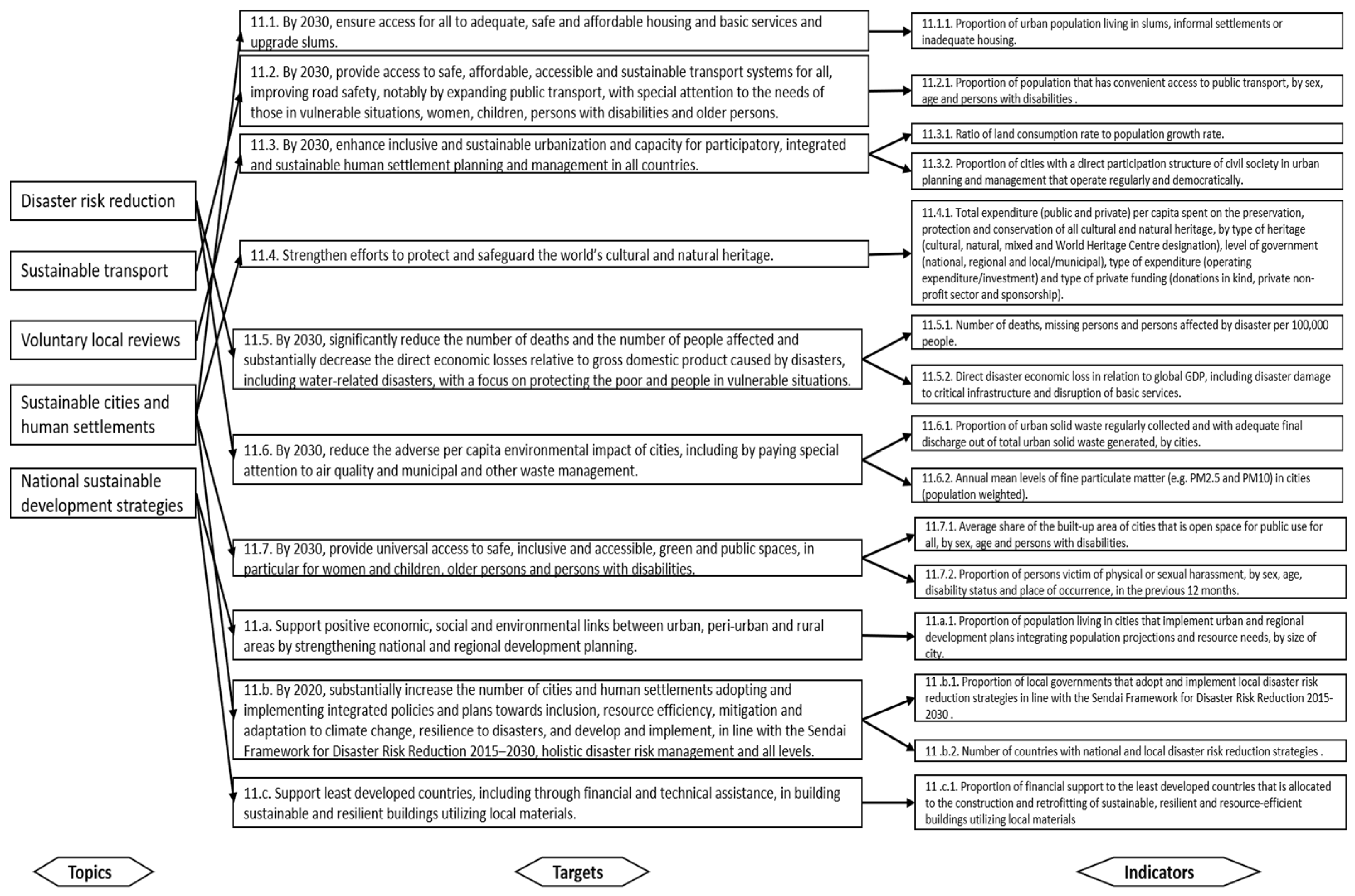
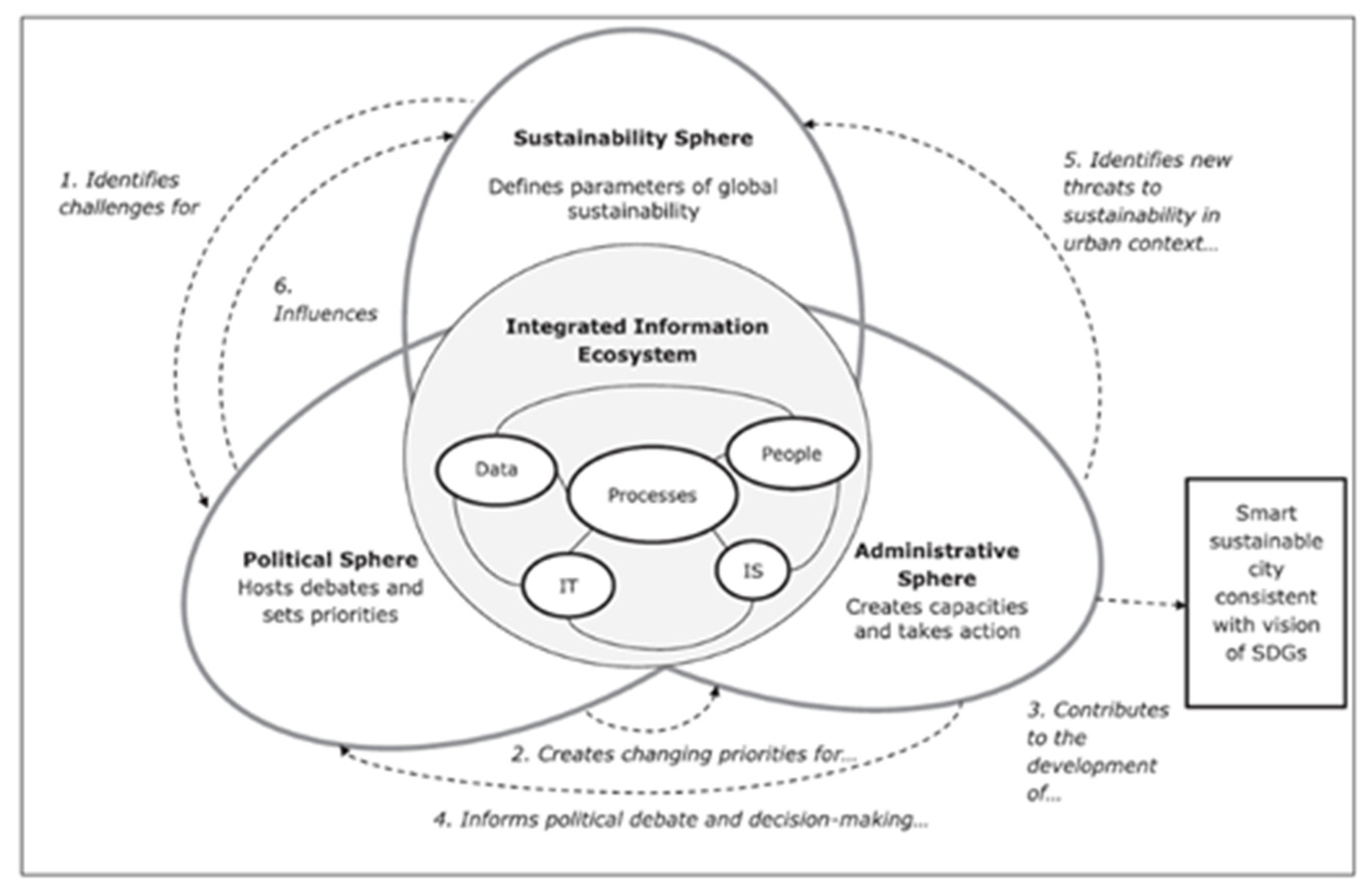





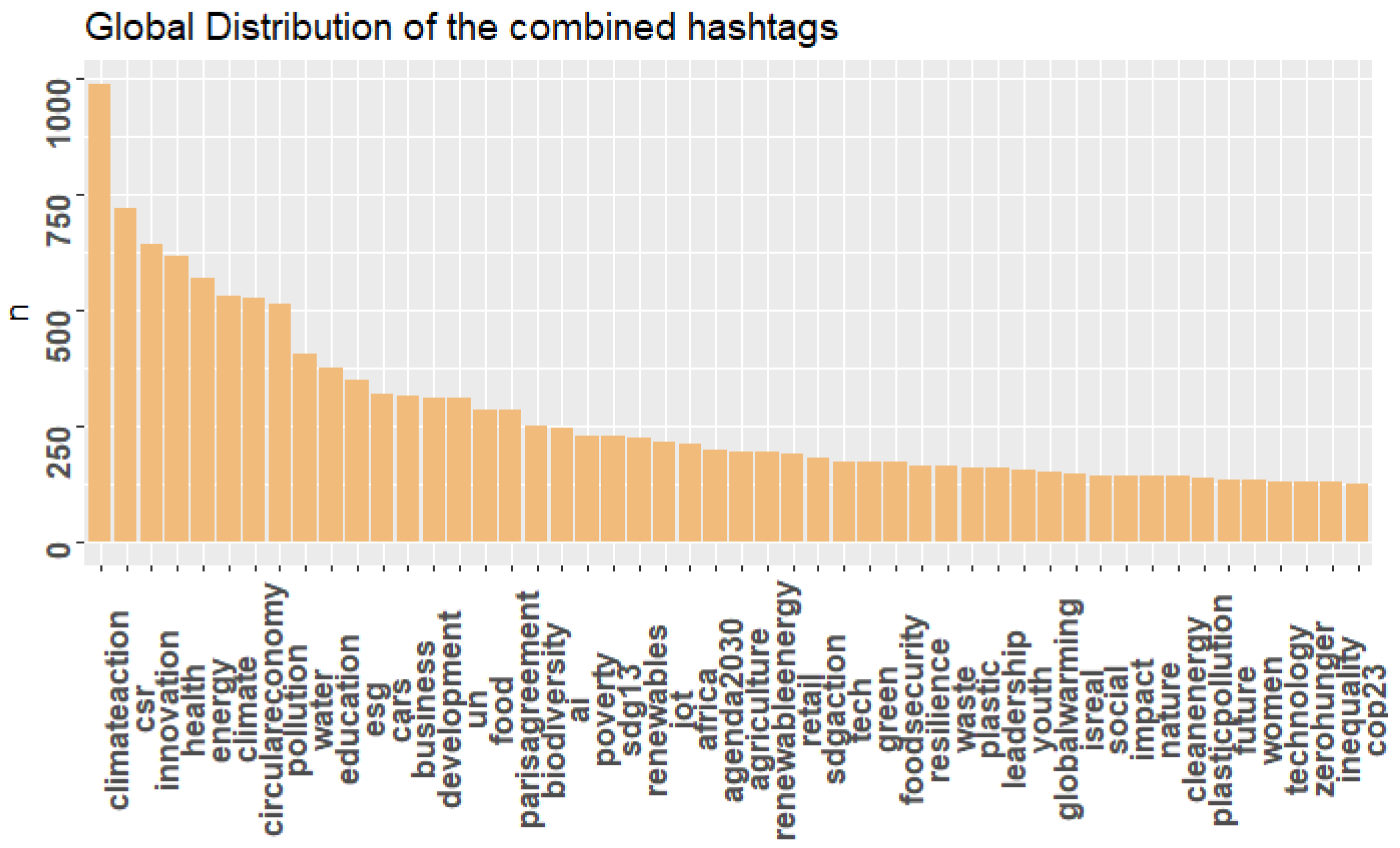

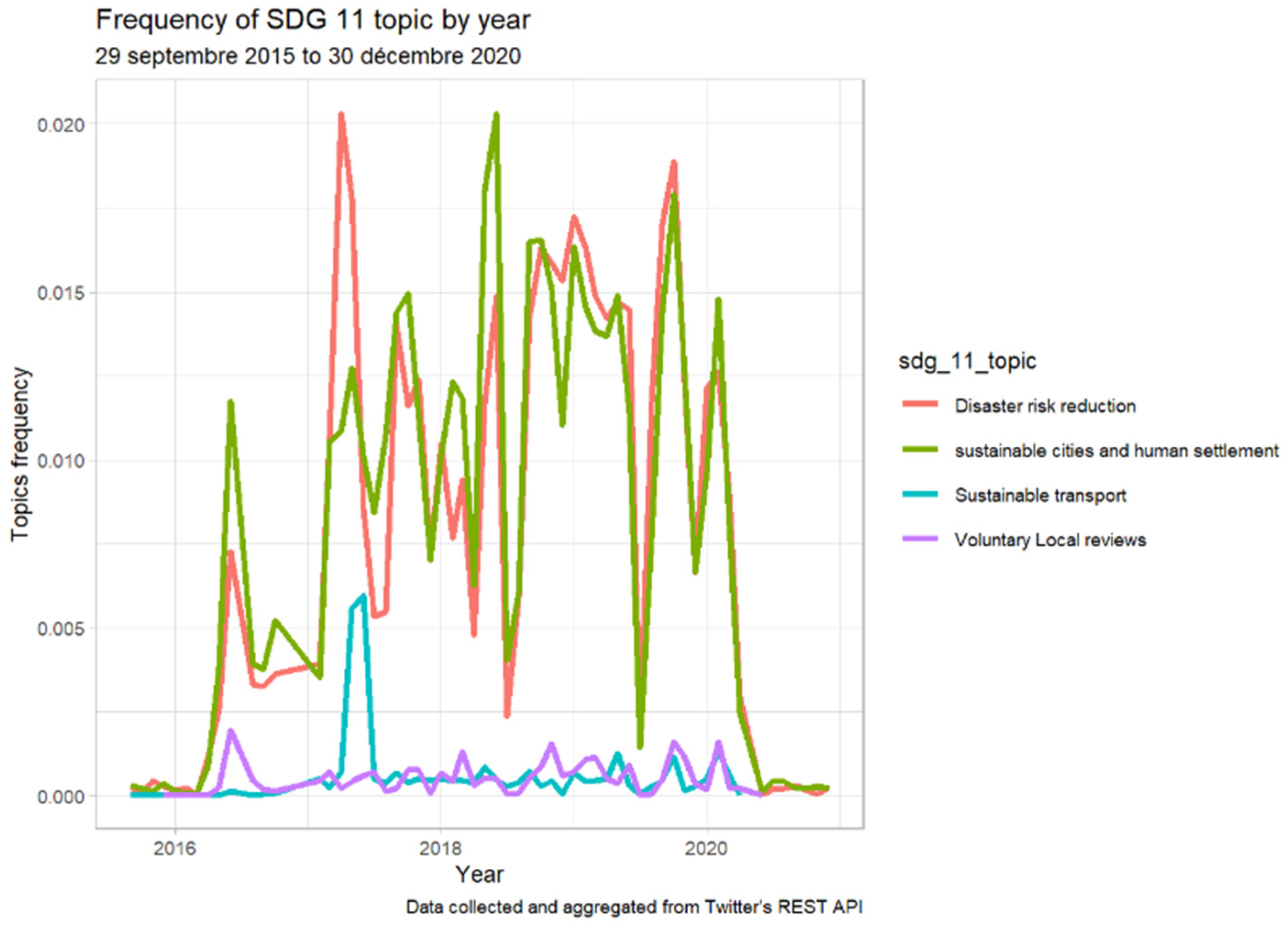
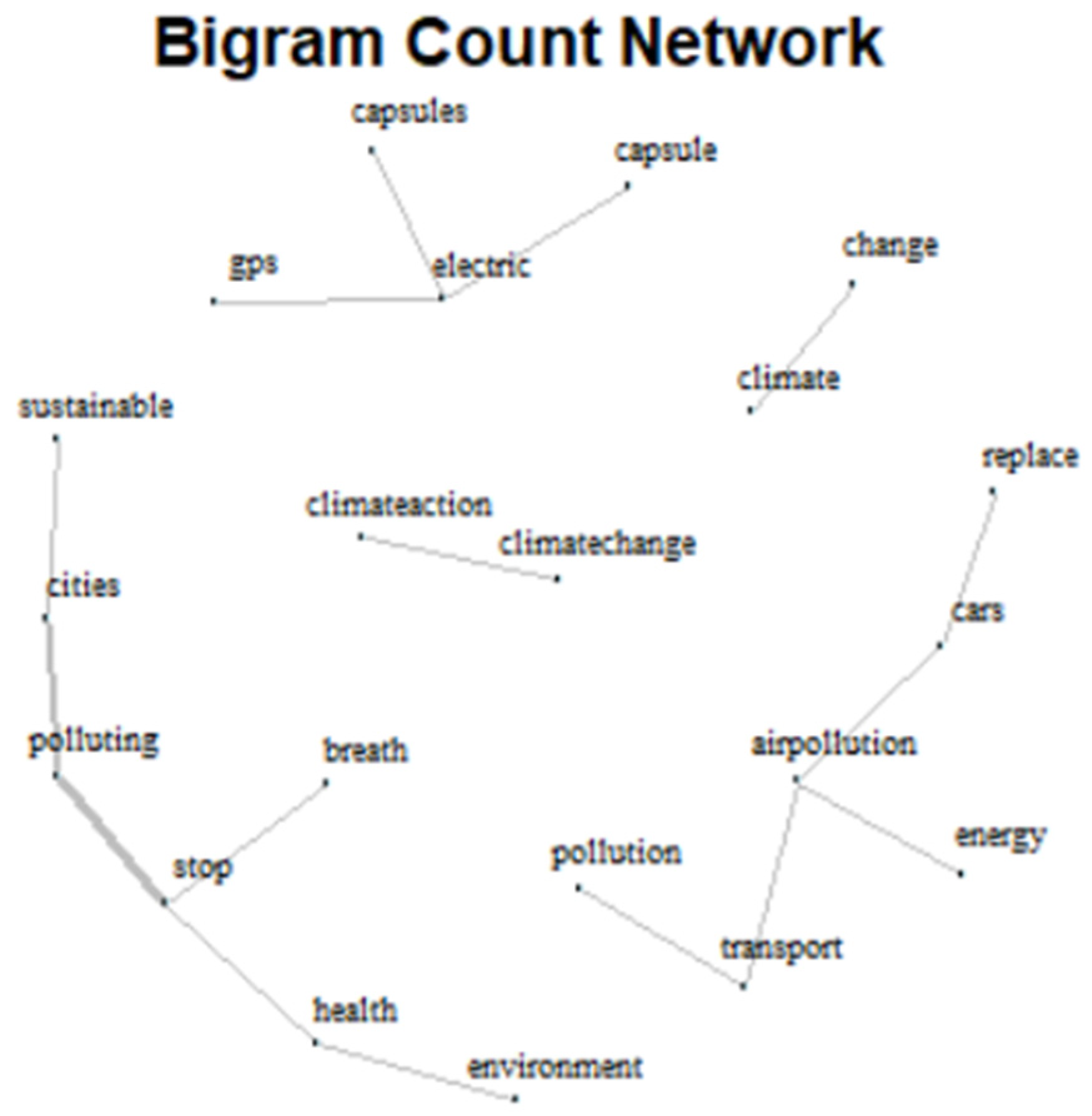
| Topic | Related Hashtags |
|---|---|
| Disaster risk reduction (https://sdgs.un.org/topics/disaster-risk-reduction; accessed on 28 March 2021) | #ecodesign |
| #urbanenvironment | |
| #airpollution | |
| Sustainable transport (https://sdgs.un.org/topics/sustainable-transport; accessed on 28 March 2021) | #urbanmobility |
| #roadtransport #publictransportation | |
| Voluntary local reviews * | #localgovernance |
| #localgov | |
| #municipality | |
| Sustainable cities and human settlements (https://sdgs.un.org/topics/sustainable-cities-and-human-settlements; accessed on 28 March 2021) | #urbandesign #affordablehousing |
| #urbanpopulation | |
| National sustainable development strategies (https://sdgs.un.org/topics/national-sustainable-development-strategies; accessed on 28 March 2021) | Hashtags non retrieved |
Publisher’s Note: MDPI stays neutral with regard to jurisdictional claims in published maps and institutional affiliations. |
© 2021 by the authors. Licensee MDPI, Basel, Switzerland. This article is an open access article distributed under the terms and conditions of the Creative Commons Attribution (CC BY) license (https://creativecommons.org/licenses/by/4.0/).
Share and Cite
Marzouki, A.; Chouikh, A.; Mellouli, S.; Haddad, R. From Sustainable Development Goals to Sustainable Cities: A Social Media Analysis for Policy-Making Decision. Sustainability 2021, 13, 8136. https://doi.org/10.3390/su13158136
Marzouki A, Chouikh A, Mellouli S, Haddad R. From Sustainable Development Goals to Sustainable Cities: A Social Media Analysis for Policy-Making Decision. Sustainability. 2021; 13(15):8136. https://doi.org/10.3390/su13158136
Chicago/Turabian StyleMarzouki, Amal, Arbi Chouikh, Sehl Mellouli, and Rim Haddad. 2021. "From Sustainable Development Goals to Sustainable Cities: A Social Media Analysis for Policy-Making Decision" Sustainability 13, no. 15: 8136. https://doi.org/10.3390/su13158136
APA StyleMarzouki, A., Chouikh, A., Mellouli, S., & Haddad, R. (2021). From Sustainable Development Goals to Sustainable Cities: A Social Media Analysis for Policy-Making Decision. Sustainability, 13(15), 8136. https://doi.org/10.3390/su13158136






